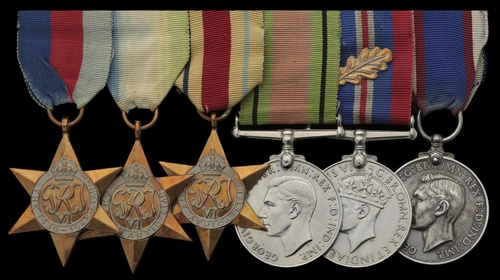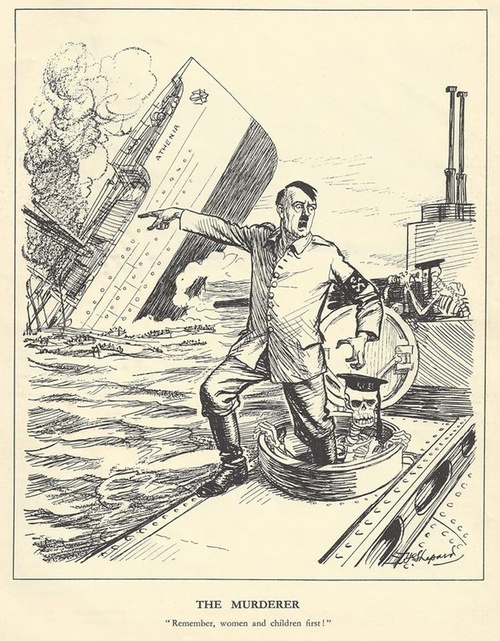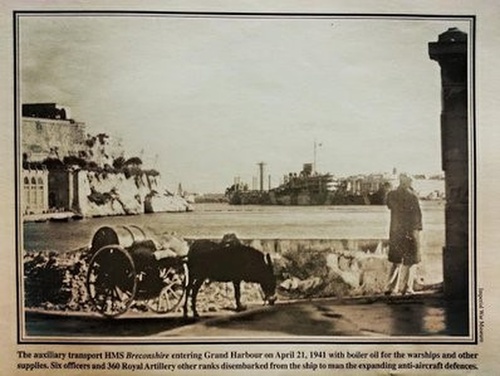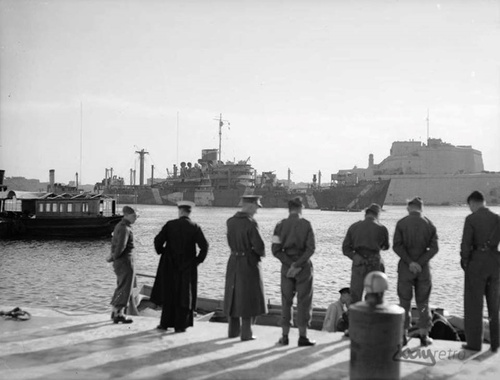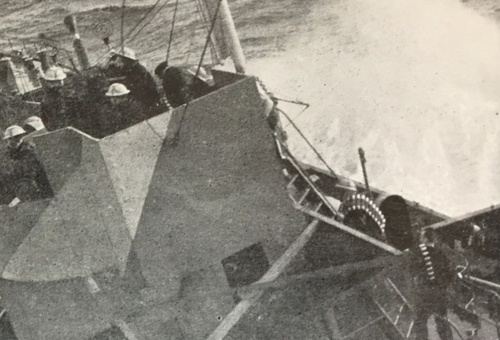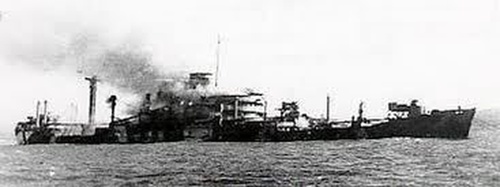Auction: 22003 - Orders, Decorations and Medals
Lot: 409
A fine Second World War Malta convoy group of six awarded to Able Seaman A. Gray, Royal Fleet Reserve, late Royal Navy
As a rating in the destroyer H.M.S. Escort, he was an early witness to the tragedy of war, participating in life saving operations following the infamous U-boat attack on the liner S.S. Athenia on the day war that was declared in September 1939: the victims included 28 U.S. citizens and a 10-year-old Canadian girl
But it was for his gallant work on the Malta run that he won a brace of well-merited "mentions", the whole enacted in H.M.S. Breconshire, a merchantman converted for use as an auxiliary supply ship, her perilous cargo often comprising vital fuel for the beleaguered island
After making more trips to Malta than any other ship - Operations "Halberd" and "Substance" among them - the gallant Breconshire finally fell victim to the Luftwaffe in March 1942
1939-45 Star; Atlantic Star; Africa Star; Defence and War Medals 1939-45, M.I.D. oak leaf; Royal Fleet Reserve L.S. & G.C., G.VI.R., 1st issue (J. 113780 (Ch. B. 25082) A. Gray, A.B., R.F.R.), generally very fine (6)
Alfred Gray was born in Faversham, Kent on 6 November 1908 and entered the Royal Navy as a Boy 2nd Class in May 1925. Having then gained advancement to Able Seaman, he came ashore 'time expired' in November 1938, when he enrolled in the Royal Fleet Reserve.
Loss of the "Athenia"
Recalled in July 1939, he joined H.M.S. Escort in the 12th Destroyer Flotilla. And it was in this capacity that he quickly bore witness to the shape of things to come, namely the infamous attack carried out by the U-30 on the liner S.S. Athenia off Ireland on 3 September 1939, just hours after the outbreak of hostilities. In the company of her consorts, Electra and Fame, Escort made her way to the scene and was credited with picking up some 400 survivors from the Athenia's boats.
However, 117 civilian passengers and crew were killed, including women and children, and the sinking was widely condemned as a war crime. The dead included 28 U.S. citizens, leading Germany to fear that the U.S. might react by joining the war on the side of the U.K. and France. Wartime German authorities denied that one of their vessels had sunk the ship, and a German admission of responsibility did not come until the Nuremburg Trials in 1946.
The Athenia had departed Glasgow for Montreal via Liverpool and Belfast on 1 September 1939, carrying 1,103 passengers, including about 500 Jewish refugees, 469 Canadians, 311 U.S. citizens and 72 U.K. subjects, and 315 crew. Despite clear indications that war would break out any day, she departed Liverpool at 1300 hours on 2 September without recall, and on the evening of the 3rd was 60 nautical miles south of Rockall and 200 nautical miles north-west of Inishtrahull, Ireland, when she was sighted by the U-30 commanded by Oberleutnant Fritz-Julius Lemp, around 1630.
Lemp later claimed that the fact that she was a darkened ship steering a zigzag course which seemed to be well off the normal shipping routes made him believe she was either a troopship, a Q-ship or an armed merchant cruiser. U-30 tracked Athenia for three hours until eventually, at 1940, when both vessels were between Rockall and Tory Island, Lemp ordered two torpedoes to be fired. One exploded on Athenia's port side in her engine room, and she began to settle by the stern. However, Athenia remained afloat for more than 14 hours, until finally sinking by the stern at 1040 the next morning.
The incident was given dramatic publicity throughout the English-speaking world, the front pages of many newspapers running photographs of the lost ship along with headlines regarding Great Britain's declaration of war.
A Canadian girl, 10-year-old Margaret Hayworth, was among the casualties, and was one of the first Canadians to be killed by enemy action. Newspapers widely publicised the story, proclaiming "Ten-Year-Old Victim of Torpedo" as "Canadians Rallying Point", and set the tone for their coverage of the rest of the war. One thousand people met the train that brought her body back to Hamilton, Ontario, and there was a public funeral attended by the mayor of Hamilton, the city council, the Lieutenant-Governor, Albert Edward Matthews, Premier Mitchell Hepburn, and the entire Ontario cabinet.
For further details, see:
https://legionmagazine.com/en/2019/08/the-sinking-of-ss-athenia/
Loss of the "Escort"
Following a refit at Falmouth in early 1940, Escort was assigned to anti-U-boat operations and, on 25 February, in the company of the destroyers Inglefield and Imogen, she assisted at the destruction of the U-63 some 90 miles off the Orkneys. Having then seen action in the Norwegian operations of April-May 1940, Escort was assigned to Force H in Gibraltar, being employed in the attack on French ships at Mers-el-Kebir on 3 July 1940, the day after her arrival.
Just over a week later, during Operation "MA 5", a planned air attack on Italian airfields in Sardinia, Escort was torpedoed by the Italian submarine Guglielmo Marconi: the torpedo blew a hole 20 feet wide between the two boiler rooms, killing two members of the crew and wounding others. Later that morning Escort foundered, by which time most of her crew had been transferred to other ships; Gray was among them.
The Malta run
In August 1940, Gray joined H.M.S. Breconshire, an ex-Holt Line vessel recently requisitioned by the Admiralty for conversion to a supply ship and tanker. Here, then, the commencement of his protracted service on the Malta run, up until Breconshire's loss to enemy aircraft in March 1942.
In fact, no other ship made as many runs to Malta as the Breconshire, her operations in 1941 commencing with "Excess" in January, when she suffered her first fatality - her Radio Officer - a victim of enemy aircraft attack whilst unloading at Valletta. Next up was "Dunlop" in April when, in addition to her valuable cargo of fuel, she carried some 360 officers and men of the Royal Artillery, the whole destined to man the guns in the island's epic defence.
Having then returned to Malta in "Splice" in May 1941, Breconshire participated in two Malta epics, "Substance" in July and "Halberd" in September. And before the year was out, Gray and his shipmates saw further action in "MD 1" in mid-December, when, laden with 5,000 tons of oil - and every space crammed with supplies - Breconshire departed Alexandria on the 15th with an escort of three cruisers and eight destroyers.
During the night she was slowed by engine trouble and on the 16th the force headed west in daylight without zig-zagging. After dark a cruiser and two destroyers turned back and made spurious wireless broadcasts to simulate the battle fleet at sea. That evening, at 6 p.m., Force K, comprising two cruisers and two destroyers, sailed to meet Breconshire and escort her into Grand Harbour. However, an Italian battleship convoy was reported to be in the vicinity and every seaworthy naval ship at Malta was now ordered out to bring in Breconshire; they met the oncoming force before dawn on 17th and quickly made a protective circle around their highly flammable charge.
The Luftwaffe and Regia Aeronautica attacked through the afternoon with bombs and torpedoes and, as night was falling, the Italian fleet did indeed arrive on the scene. Breconshire and two escorts were diverted to the south-west as the rest of the escort turned towards the enemy fleet. The opposing ships having diverged in the dark, Force K turned for Malta with Breconshire; they spent the 18th under renewed air attack, until Malta's Hurricanes arrived in the afternoon and at around 3.00 p.m. the ships finally made it into Valletta.
Just a few weeks later, in January 1942, Breconshire continued her heroic and relentless efforts to save the beleaguered island, returning in triumph with yet another valuable cargo of fuel.
Gray's good work was recognised by a mention in despatches (London Gazette 11 June 1942, refers).
Loss of the "Breconshire"
However, in March 1942, under the command of Captain Colin Hutchinson, R.N., Breconshire fought her last battle. As part of Operation "MG1" - and acting as commodore ship - she departed Alexandria on 20 March, laden with a cargo of high explosive and kerosene; she was accompanied by the Clan Campbell, Pampas and Talabot.
The next day, by which time the Clan Campbell was straggling, the convoy was met by Admiral Vian in the cruiser Cleopatra, three other cruisers and 16 destroyers. Aircraft provided overhead cover and three submarines were patrolling to the north. On the 22nd there were several ineffective attacks by Italian Savoia bombers and H.M. submarine P 36 reported a heavy Italian surface fleet steaming to intercept. At 1330 hours an aircraft dropped a line of flares to guide the Italian force towards the convoy, heralding the commencement of the Battle of Sirte. Six destroyers and the anti-aircraft cruiser Carlisle were delegated to protect the convoy while the remainder of the escort steamed off to meet the oncoming Italians; although a smoke screen was laid to protect the merchantmen, bombing attacks had started by mid-afternoon, all the ships being straddled but, fortunately, not hit.
By late-afternoon the Italian cruiser Littorio, three cruisers and 12 destroyers arrived on the scene and the convoy was ordered to alter course, southward, into the Sirte Gulf. Laying a smoke screen Vian's fleet went after the Italians whose objective was to get round the smoke to get a clear shot at the convoy. As they broke through Vian's Cleopatra fired a broadside of torpedoes which caused the Italians to turn away. The manoeuvre was repeated and after another broadside was fired the Italians withdrew and the battle was over.
However, by now the merchantmen were so far south that they could not possibly reach Malta, some 240 miles away, under the cover of darkness. As the main escort no longer had the fuel or ammunition to provide effective cover Vian ordered the merchantmen to break convoy and head for Grand Harbour, Valletta at full speed. The Breconshire set off at 17 knots accompanied by the destroyers Southwold and Beaufort and the A.A. cruiser Carlisle and, by daybreak, they were only 20 miles from Malta. But enemy aircraft were already circling waiting to attack; air support was requested but nothing was available to cover the ships as they approached the island.
On the 23rd, a single Junkers 88 commenced an attack which was followed by Me. 109s, who scored three hits. The Ju. 88s now returned at regular intervals, scoring more hits, and before long Breconshire was lying dead in the water, 10 miles from her goal. The cruiser Penelope left Valletta Harbour to take the ship in tow but 20 ft. waves caused the tow to part leaving her to drift towards the protective minefields. By noon she managed to anchor short of the minefields and two cruisers and four destroyers gave her anti-aircraft protection.
During the following night the anchors dragged and the mines were close enough to be clearly visible from the ship. Southwold managed to get a tow line aboard but in doing so hit a mine and broke her back, finally sinking later that day. The air attacks recommenced but the Breconshire was not hit and by midnight the weather abated sufficiently to allow H.M. tugs Ancient and Robust to reach the stricken ship. At 2.00 a.m. on the 25th she was under tow but a strong wind prevented entry into Grand Harbour, so it was decided to put her in Marsaxlokk Bay. As the ship turned the swell caused her to veer badly. Breconshire signalled the Ancient 'I have a strong tendency to come up into wind', to which Ancient replied 'You're telling me!' At 10.00 Breconshire entered the bay and moored to No.1 buoy, Her exhausted crew were taken off for some well-earned rest.
The tanker Plumleaf was delegated to go alongside and take off the kerosene and fuel oil but this could not be done until the tanks were freed and opened. While this was being done Plumleaf was bombed and beached. The Luftwaffe, determined to destroy the three merchantmen who made it, now increased their air attacks with the Pampas and the Talabot being rendered unrecognisable and Breconshire being repeatedly dive-bombed. On the 26th, hasty repairs were commenced so that she could be towed into Grand Harbour. The air attacks resumed and, at 1830, a lone Ju. 88 scored four direct hits which caused a fire that was quickly brought under control. Miraculously the ship did not explode but she was settling and listing to port and by sunset the port rail was under water. At daybreak on the 27th she was still afloat but fires had again broken out, and abaft the No.3 hold was a blazing inferno and ammunition was beginning to explode. The Captain and 14 of her crew went out to her by launch but attempts to scuttle her failed because of the intensive heat. Moments after Captain Hutchinson slid off the ship she rolled on her side and then capsized.
For his gallantry in Breconshire's final mission, Gray was again mentioned in despatches (London Gazette 8 September 1942, refers). The recommendation states:
'He was Layer of 'Y' 12-pounder. Kept his gun's crew steady by his coolness. Throughout the action on Sunday 22 March [1942] P.M. and again in the air attacks on the 23rd, 24th and 25th March. On 25th March a large bomb burst close to his gun but he continued in action until the attack was over.'
Having returned to the U.K. following her loss, Gray served at the Landing Craft Training Base Helder at Brightlingsea, Essex from June 1943 until September 1944. He was released 'Class A' in October 1945.
Sold with the recipient's original M.I.D. certificates and Certificate of Service.
Subject to 20% VAT on Buyer’s Premium. For more information please view Terms and Conditions for Buyers.
Sold for
£320
Starting price
£250

